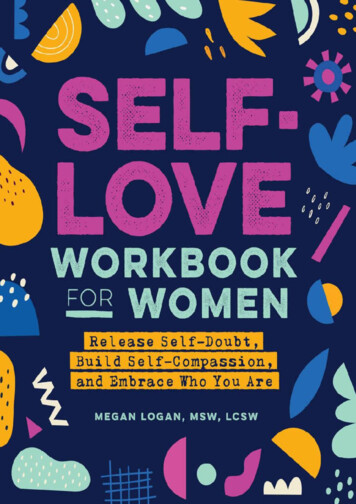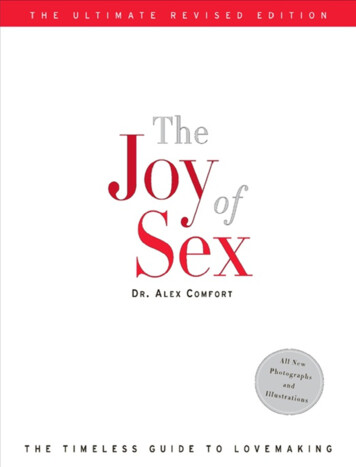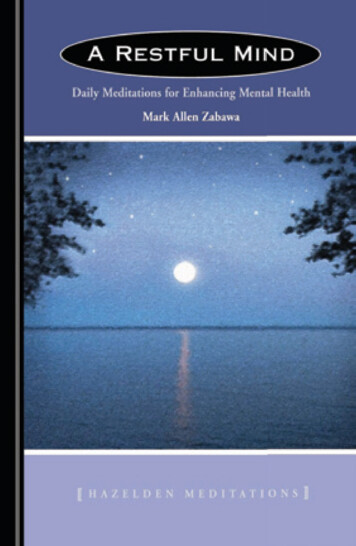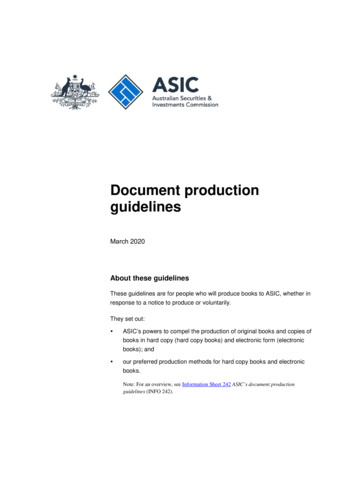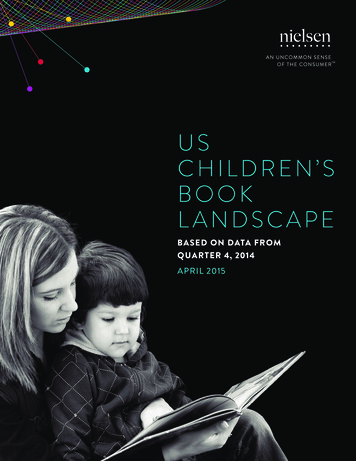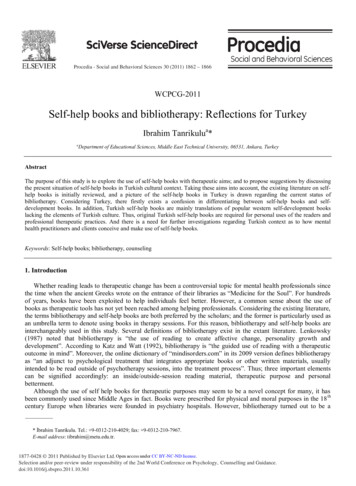
Transcription
Procedia - Social and Behavioral Sciences 00 (2011) 000–000Procedia - Social and Behavioral Sciences 30 (2011) 1862 – 1866ProcediaSocial diaWCPCG-2011Self-help books and bibliotherapy: Reflections for TurkeyIbrahim Tanrikulua*aDepartment of Educational Sciences, Middle East Technical University, 06531, Ankara, TurkeyAbstractThe purpose of this study is to explore the use of self-help books with therapeutic aims; and to propose suggestions by discussingthe present situation of self-help books in Turkish cultural context. Taking these aims into account, the existing literature on selfhelp books is initially reviewed, and a picture of the self-help books in Turkey is drawn regarding the current status ofbibliotherapy. Considering Turkey, there firstly exists a confusion in differentiating between self-help books and selfdevelopment books. In addition, Turkish self-help books are mainly translations of popular western self-development bookslacking the elements of Turkish culture. Thus, original Turkish self-help books are required for personal uses of the readers andprofessional therapeutic practices. And there is a need for further investigations regarding Turkish context as to how mentalhealth practitioners and clients conceive and make use of self-help books.Keywords: Self-help books; bibliotherapy, counseling1. IntroductionWhether reading leads to therapeutic change has been a controversial topic for mental health professionals sincethe time when the ancient Greeks wrote on the entrance of their libraries as “Medicine for the Soul”. For hundredsof years, books have been exploited to help individuals feel better. However, a common sense about the use ofbooks as therapeutic tools has not yet been reached among helping professionals. Considering the existing literature,the terms bibliotherapy and self-help books are both preferred by the scholars; and the former is particularly used asan umbrella term to denote using books in therapy sessions. For this reason, bibliotherapy and self-help books areinterchangeably used in this study. Several definitions of bibliotherapy exist in the extant literature. Lenkowsky(1987) noted that bibliotherapy is “the use of reading to create affective change, personality growth anddevelopment”. According to Katz and Watt (1992), bibliotherapy is “the guided use of reading with a therapeuticoutcome in mind”. Moreover, the online dictionary of “mindisorders.com” in its 2009 version defines bibliotherapyas “an adjunct to psychological treatment that integrates appropriate books or other written materials, usuallyintended to be read outside of psychotherapy sessions, into the treatment process”. Thus; three important elementscan be signified accordingly: an inside/outside-session reading material, therapeutic purpose and personalbetterment.Although the use of self help books for therapeutic purposes may seem to be a novel concept for many, it hasbeen commonly used since Middle Ages in fact. Books were prescribed for physical and moral purposes in the 18 thcentury Europe when libraries were founded in psychiatry hospitals. However, bibliotherapy turned out to be a* İbrahim Tanrikulu. Tel.: 9-0312-210-4029; fax: 9-0312-210-7967.E-mail address: tibrahim@metu.edu.tr.1877-0428 2011 Published by Elsevier Ltd. Open access under CC BY-NC-ND license.Selection and/or peer-review under responsibility of the 2nd World Conference on Psychology, Counselling and Guidance.doi:10.1016/j.sbspro.2011.10.361
IbrahimTanrikulu/ Procedia- SocialandandBehavioralSciences30 (2011)1862– 1866İbrahimTanrıkulu/ Procedia– SocialBehavioralSciences00 (2011)000–0001863popular topic in the second part of the 20th century for counselors, social workers, psychologists and educators. Inthe present day, the already existing literature of bibliotherapy has been growing more and more. Regarding theexisting Turkish literature on bibliotherapy, studies were flourished in the late 1980s (Öner, 1987) and have becomeprevailing in the 2000s (e.g. Karacan & Yerin-Güneri, 2010; Öner, 2007). Despite the existence of self-help booksin the Turkish market for many years, the use of books for therapeutic aims is quite new. Thus, this current studyintends to explore the history/the nature, the advantages and limitations of the use of self-help books withtherapeutic aims in therapy sessions; and to discuss the current state of self-help books in Turkish cultural context byproviding suggestions.2. Review of LiteratureThe current literature has elaborated several aspects of bibliotherapy. Four stages were identified inbibliotherapy process (Öner, 2007). Initially, the clients are expected to identify themselves with a story characterthat bears similarities to their own lives. Then, clients live through a catharsis, an emotional release after they realizethat they are not alone in experiencing problems; the clients may orally state, write, draw or even role-play toconvey their feelings (Sridhar & Vaughn, 2000). After the catharsis, the clients gain insight through theinvestigation of the decisions and action of the attributed character. By this way, the clients are assisted to createtheir own problem solving mechanisms (Gregory & Vessey, 2004). In addition, Campbell and Smith (2003)identified six main goals of bibliotherapy; providing information, generating insight, stimulating discussion, creatingawareness of others’ problems, providing solutions to problems and settling problems. Analyzing the bibliotherapyliterature, Lenkowsky (1987) stated that there may be four applications of bibliotherapy. To begin with,bibliotherapy can be utilized as a “self-actualization/ problem solving” tool to endorse better self-understanding andproblem solving. Secondly, bibliotherapy may be aimed for “social utilization” to reinforce a person’s socialawareness. The next one is the “psychotherapeutic utilization” which intends to develop psychological insight andgrowth. Lastly, self-help books may be applied for “educational and didactic utilization” to teach how to usebibliotherapy. Reflecting on how to integrate self-help books into psychotherapy, Campbell and Smith (2003)suggested that therapists should initially decide whether to use a self-help book as an adjunctive (homework) orintegrative purpose (in session). Therapists’ second concern should be whether to assign fiction or nonfiction books.In detailed terms, clients will identify themselves with a character in a fiction book; on the other hand, nonfictionbooks tell the problem solving method of a particular issue in a step by step fashion. Finally, clinical use of the selfhelp books in such cases as depression, anxiety or eating disorders, or their informational use regarding stepfamilies, communication skills or weight management should be considered together for an efficient integration.The readership profile of the self-help books and the cultural matters were interests of the researchers. Forexample, Wilson & Cash (2000) stated that having a positive attitude towards reading in general, being morepsychologically minded, having a stronger self-control and having greater life satisfaction were the factorspredicting a favorable view towards self-help books. In addition, women and psychology majors were reported to bemore positive towards bibliotherapy in the same study. According to Bergsma (2008), the readers of the Dutchmonthly “Psychology Magazine” were mostly rich and highly educated females (73%) aged between 20-50. Thesefindings indicate that demographic variables (age, gender, education and socio-economic status) and personalitycharacteristics play an important role in assigning clients a self-help book. Culture also seems to be a key aspect inthe use of self-help books. In effect, self-help books were considered as fitting well to an individualistic culture inwhich persons can follow happiness freely for their own sake (Bergsma, 2008). According to Starker (1989), sincepeople can rise with the help of their own abilities, and they can only be judged on their own individualaccomplishments, self-help is an essential component of the American culture.Bibliotherapy has been widely utilized for various types of problems such as depression, anxiety, obsessivecompulsive disorder, stress, personal growth, child rearing, sexuality or communication with a partner. Amongthese, depression is the most common one which has drawn the most attention from the researchers (Cuijpers, 1997;Anderson et al., 2005; Richardson, Richards & Barkham, 2008). Starker (1989) cited four practical reasons of thewide use of self help books. Firstly, self-help books have cost-effectiveness; that is, it is cheaper than to consult aprofessional. Next, they are easily accessible; whenever a person needs help, they are within access. Privacy is thethird factor that encourages people to explore their problem on their own. Lastly, self-help books provide excitementfor their readers because they easily become a member of an in-group of a best-seller self-help book; and thus, theyhave something to share with the others. Nevertheless, Bergsma (2008) investigated 57 best-selling self-help booksin the Netherlands and pointed out that these books chiefly aimed to boost personal capabilities rather than lessening
1864İbrahimTanrıkulu/ Procedia– brahimTanrikulu/ Procedia- SocialBehavioralSciences(2011)1862 – 1866the psychological symptoms of the problems. The same study also reported that personal growth, personal relations,coping with stress and identity were the main themes of those books. Furthermore, researchers have developeddifferent schemes for self-help book prescription. Although there are more than 20 diverse self-help book schemes,the first original scheme from which the others were adapted was Cardiff model (Frude, 2004). The Cardiff modelentails that the clients initially present their problem to the helping professional; then, the practitioner prescribes asuitable self-help book from a list covering the essential health topics; after that the clients take their self-help bookfrom a library where self-help books are thematically, and systematically stored. According to Farrand (2005), aneffective self-help book scheme will not only increase access to a feasible form of psychological treatment but it willalso facilitate making self-help approach available to a great number of individuals. Farrand (2005) proposed a newmodel named “the Devon Supported Self-Help Book Prescription Scheme” which is different from others in termsof the provision of the support of the mental health specialist. In this model, the practitioner provides an explanationof the self-help process, and the client is the one who decides to pursue a self-help book treatment. Clients get theirbook from the public libraries, and they obtain support from the practitioner throughout the treatment process.Turkish academic works concerning bibliotherapy can be grouped in two categories; literature reviews andexperimental studies. Literature reviews mainly addressed the definitions and therapeutic uses of self-help books fordifferent age groups (Bulut, 2010; Öner, 1987; Öner & Yeşilyaprak, 2006; Öner, 2007; Uçar, 1996). Regarding theexperimental studies, Yılmaz (2002) found out a significant positive effect of biblio-counseling in the degree ofparent-teen conflicts which ninth grade high school students experienced. Another experimental study conducted byKaracan and Yerin-Güneri (2010) explored the effectiveness of a self-esteem enhancement biblio-counselingprogram on the self-esteem of the sixth grade secondary school students. The results of this study indicated that theself-esteem scores of the students who were treated by the program significantly increased. Regarding Turkey, it isclear that more studies are needed in the use of self-help books with therapeutic goals. Thus, this study aims todiscuss the current state of self-help books and the use of bibliotherapy by offering some suggestions for thetherapeutic use of self-help books in Turkey.3. Positive Arguments on Self-help BooksThere are studies asserting that bibliotherapy is an effective technique that can bring about behavioral andemotional change (Karacan & Yerin-Güneri, 2010; Yılmaz, 2002). Bergsma (2008) believes that there is a goodreason to expect positive outcomes from employing self-help books as the messages of the self-help books fit wellfor cliental situations. For example, participants from a survey examining the readers’ evaluations of self-help booksreported that self-help books were helpful for them in several respects; opening new paths, providing more selfconfidence, helping to understand themselves and others, gaining insight, having a peace of mind and learning aboutstress (Starker, 1989). The results of another study (Starker, 1988) exploring attitudes and practices of 123psychologists toward self-help books indicated that psychologists praising self-help books positively were thefrequent readers and supporters of the therapeutic value of self-help books. In a study (Keeley, Williams, & Shapiro,2002) surveying 265 British cognitive behavior therapists’ attitudes towards and use of structured self-helpmaterials, it was found that 88.7% of the therapist generally used self-help materials like books, audio tapes, videotapes and computerized delivery. Of these materials, 94.8% of them was in written form. Accordingly, depression,anxiety and obsessive compulsive disorder were the most common problems which were dealt with mostly writtenmaterials with a CBT approach. Yet, the same study emphasized that only 36.2% of the participants had training onthe use of self-help materials; thus, it is not surprising that educated cognitive behavior therapists had more positiveattitudes and advised self-help materials more. As mentioned before, the empirical studies about the effectiveness ofbibliotherapy largely involve treatment of depression. In a meta-analysis of self-administered treatments of threedepression bibliotherapy treatments, an effect size of 0.74 was reported (Gould& Clum, 1993). Furthermore,Cuijpers (1997) got an effect size of 0.83 from a meta-analysis of seven depression bibliotherapy studies. In additionto the studies of depression, several meta-analytic studies exploring whether bibliotherapy yielded positive resultshave been conducted by researchers (Scogin, Bynum, Stephens, & Calhoon, 1990; Marrs, 1995) and these studiesresulted an effect size above .50 (large effect) which means bibliotherapy can be an effective treatment approach.4. Arguments on the Limitations of Self-help BooksIn contrast to the works supporting bibliotherapy, there is research arguing bibliotherapy is not as efficient
IbrahimTanrikulu/ Procedia- SocialandandBehavioralSciences30 (2011)1862– 1866İbrahimTanrıkulu/ Procedia– SocialBehavioralSciences00 (2011)000–0001865as claimed. A study (Febbraro, Clum, Roodman & Wright, 1999) comparing the differential effectiveness ofbibliotherapy alone, and bibliotherapy plus daily self-monitoring, monitoring alone and wait-list in persons withpanic attacks revealed conflicting results. First of all, bibliotherapy was not found to be an effective treatment forpanic disorder. What is more, even the amplified therapist contact plus self-help books did not have any effect incontrast to the existing studies (e.g. Marrs, 1995) stating therapist contact is significant in dealing with anxiety viabibliotherapy. Moreover, Paul (2001) thinks that self-help books are full of myths; and readers should be wary of themyths while reading them. According to Bergsma (2008), another limitation of self-help books is the idea of “onesize fits all”; that is, self-help books are laden with hundreds of suggestions for the betterment of the individuals.However, each individual brings a different personality and problem to the therapy sessions. Researchers also warnthat a self-help book intending for important changes in a person may also have harmful results. To illustrate, Rosen(1987) argued that a self-help book may cause individuals to blame themselves, and their symptoms may even getworse. In their study examining how to integrate self-help books into psychotherapy, Campbell and Smith (2003)proposed that without considering several factors like client characteristics (demographic, ethnic and culturalcharacteristics), goals and professional standards (training, ethics) before assigning a self-help book to a client, itwould not be a meaningful intervention. Indeed, studies also indicated that demographic and personal characteristicsof the individuals have a gross effect on helping individuals (Wilson & Cash, 2000; Bergsma, 2008). Ignoring theculture in which people live is another concern reported by the studies. Cherry (2008) assumes that self-help bookstake the individuals as the basis for intervention and forget about the social influence on themselves. Theindividualistic perspective of the self-help books were also criticized by McGee (2005) stating that people haveunique characteristics tailored in their cultural context. Moreover, self-help books are highly criticized by feministscholars since they think that self-help books victimize women by disregarding the cultural context of theindividuals (Kaminer, 1993; Simonds, 1992). For example, a study (Zimmerman, Holm, & Haddock, 2001)analyzing the top 10 books on the New York Times best-seller list over 10 years (1988-1998) concluded that nearlyall of the books considered the gender as a major focus. And almost half of the books obviously and particularlysupported the traditional, power-based women and men relationship; and most of the advice for betterment was forfemales.5. DiscussionBefore discussing the present situation of bibliotherapy in Turkey, it should be noted that a confusion existsabout the Turkish description of the self-help books. The term “self-development book” is mostly used in Turkey torefer to all types books related to self-assistance. Interestingly however, there is a distinction between “self-helpbooks” and “self-development books” in American and European sources. While the former covers the books onmental health, friendship, confidence, spiritual enlightenment, intimacy or stress; the latter comprises the booksdealing with student success, richness or personal achievement. Hence, to avoid the confusion, an initial distinctionbetween self-help books and self-development books is required. So, bibliotherapy as a cost effective, self-healingapproach may offer innovative modalities for individual and group practices to the Turkish counselors andtherapists. In fact, Yılmaz (2002), Karacan and Yerin-Güneri (2010) have already reported that biblio-counselingwas effective in parent-teen conflicts and self-esteem enrichment in Turkish schools. According to the 2009-2010data of the Turkish Ministry of education (http://orgm.meb.gov.tr/), the vast majority of the counselors are serving inthe schools. Thus, gaining information and practice about bibliotherapy becomes particularly significant for schoolcounselors. For this reason, bibliotherapy courses should be included in the undergraduate and graduate syllabusesand in-service training for the school counselors are also required.Self-help books have a certain readership profile including highly educated, wealthy, and mostly femaleindividuals (Wilson & Cash, 2000; Bergsma, 2008). There is no scientific data at hand analyzing the readershipprofile of self-development books in Turkey. Yet, in accordance with the recent statistics supplied by the TurkishStatistical Institute (http://www.tuik.gov.tr/), economic welfare of Turkey is getting better; the number of the stateand private universities is getting higher, and the education level of the women is getting upper. Considering these,it is quite possible to anticipate a significant raise in Turkish clients’ attention to the self-help books andbibliotherapy in the close future. However, it appears that self-development and self-help book translations areprobably the biggest problem for Turkey. Self-help book literature is largely dominated by translations of best-sellerself-development books which have gained popularity in the world. In addition to the translations, some Turkish
1866IbrahimTanrikulu/ Procedia- SocialBehavioralSciences(2011)1862 – 1866İbrahimTanrıkulu/ Procedia– uthors have published books on self-development topics which belong to Western specific values such as success,power of thinking, emotional intelligence and individual-self discovery. Nonetheless, no fiction or non-fiction,original, Turkish self-help book to be employed in therapy or counseling sessions could be presently encountered inthe market. For these reasons, self-help and self-development books originally written by Turkish researchers byconsidering the Turkish cultural values and its components are needed for personal and therapeutic uses. In effect,self-help and self-development books which are parallel with Turkish culture can assist Turkish individuals inpersonal and social aspects. All in all, as a novel therapeutic practice attracting the attention of counselors andpsychologists, bibliotherapy seems to be a conflicting subject for all researchers as well as the Turkish ones (e.g.Keeley, Williams, & Shapiro, 2002; Paul, 2001). Regarding the number of the research at hand, it is obvious thatmore research should be conducted upon the usage of self-help books and effectiveness of bibliotherapy practiceswith Turkish participants. With the increasing number of the studies concerning bibliotherapy, it can be possible tobuild up a bibliotherapy model which is specific to the Turkish culture.ReferencesAnderson, L., Lewis, G., Araya, R., Elgie, R., Harrison, G., Proudfoot, J., Schmidt, U., (2005). Self-help books for depression: How canpractitioners and patients make the right choice? British Journal of General Practice, 55, 387-92.Bergsma, A. (2008). Do self-help books help? Journal of Happiness Studies, 9, 341-360.Bulut, S. (2010). Yetişkinlerle yapılan psikolojik danışmada bibliyoterapi (okuma yoluyla sağaltım) yönteminin kullanılması. Türk PsikolojikDanışma ve Rehberlik Dergisi, 33, 46-56.Campbell, L. F., & Smith, T. P. (2003). Integrating self-help books into psychotherapy. Journal of Clinical Psychology in Session, 59, 177-186.Cherry, S. A. (2008). The Ontology of a Self-Help Book: A Paradox of its Own Existence, Social Semiotics, 18(3), 337-348.Cuijpers, P. (1997). Bibliotherapy in unipolar depression: A meta-analysis. Journal of Behavior Therapy & Experiential Psychiatry, 28,139-147.Farrand, P. (2005). Development of a supported self-help book prescription scheme in primary care. Primary Care Mental Health, 3, 61-66.Febbraro, G. A. R., Clum, G. A., Roodman, A. A., & Wright, J. H. (1999). The limits of bibliotherapy: A study of the differential effectiveness ofself-administered interventions in individuals with panic attacks. Behavior Therapy, 30, 209-222.Frude N. (2004). A primary care based book prescription scheme. Clinical Psychologist, 39, 11–14.Gould, R., & Clum, G. (1993). A meta-analysis of self-help treatment approaches. Clinical Psychology Review, 13, 169-186.Gregory, K. E., & Vessey, J. A. (2004). Bibliotherapy: A strategy to help students with bullying. Journal of School Nursing, 20(3), 127–133.Kaminer, W. (1993). I’m dysfunctional, you’re dysfunctional: The recovery movement and other self-help fashions. New York: Vintage Books.Karacan, N., & Yerin-Güneri, O. (2010). The effect of self-esteem enrichment bibliocounseling program on the self-esteem of sixth gradestudents. Procedia –Social and Behavioral Sciences, 5, 318-322.Katz, G., & Watt, J. (1992). Bibliotherapy: The use of books in psychiatric treatment. Canadian Journal of Psychiatry, 37, 173-178.Keeley, H., Wiliams, C., & Shapiro, D. A. (2002). A united kingdom survey of accredited cognitive behaviour therapists’ attitudes towards anduse of structured self-help materials. Behavioral and Cognitive Psychotherapy, 30, 193-203.Lenkowsky, R. S. (1987). Bibliotherapy: A review and analysis of the literature. The Journal of Special Education, 21, 123-132.Marrs, R. W. (1995). A meta-analysis of bibliotherapy studies. American Journal of Community Psychology, 23, 843-870.McGee, M. (2005). Self-help, Inc. Makeover culture in American life. Oxford: Oxford University Press.Öner, U. (1987). Bibliyoterapi. Ankara Üniversitesi, Eğitim Bilimleri Fakültesi Dergisi, 20, 1–2.Öner, U. (2007). Bibliyoterapi. Çankaya Üniversitesi, Fen-Edebiyat Fakültesi Dergisi, 7, 133-149.Öner, U., & Yeşilyaprak, B. (2006). Bibliyoterapi: Psikolojik Danışma ve Rehberlik Programlarında Çocuk Edebiyatından Yararlanma. II. UlusalÇocuk ve Gençlik Edebiyatı Sempozyumu, 203, Ankara, 559–565.Paul, A. M. (2001). Self-Help: Shattering the Myths. Psychology Today, March.Richardson, R., Richards, D. A., & Barkham, B. (2008). Self-help books for people with depression: A scoping review. Journal of Mental Health,17, 543-52.Rosen, G. M. (1987) Self-help treatment books and the commercialization of psychotherapy. American psychologist, 42, 46–51.Scogin, F., Bynum, J., Stephens, G., & Calhoon, S. (1990). Efficacy of self-administered treatment programs: Meta-analytic review.Professional Psychology, 21, 42-47.Simonds, W. (1992). Women and self-help culture: Reading between the lines. New Brunswick, NJ: Rutgers University Press.Sridhar, D., & Vaughn, S. (2000). Bibliotherapy for all. Teaching Exceptional Children, 33(2), 74-82.Starker, S. (1988).Psychologists and self-help books: Attitudes and prescriptive practices of clinicians. American J. of Psychotherapy, 3, 448-55.Starker, S. (1989). Oracle at the supermarket; The American preoccupation with self-help books. New Brunswick: Transaction Publishers.Uçar, Ö. (1996). Ortaöğretim rehberlik hizmetlerinde edebiyat eserlerinden yararlanma. Unpublished master’s thesis, Ankara University, Ankara.Wilson, D. M., & Cash, T. F. (2000). Who reads self-help books? Development and validation of the Self-help reading attitudes survey.Personality and Individual Differences, 29, 199-129.Yılmaz, E. B. (2002). Bibliyoterapinin aileleriyle çatışma içinde olan gençlerin çatışma düzeylerine etkisi. Unpublished master’s thesis, GaziUniversity, Ankara.Zimmerman, T. S., Holm, K. E., & Haddock, S. A. (2001). A decade of advice for women and men in the best-selling self-help literature.Family Relations, 50, 122-133.
In addition, Turkish self-help books are mainly translations of popular western self-development books lacking the elements of Turkish culture. Thus, original Turkish self-help books are required for personal uses of the readers and professional therapeutic practices. And there is a need for further investigations regarding Turkish context as .



